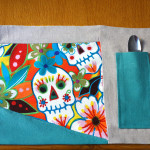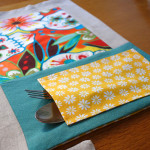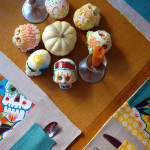January 9, 2014
by cablackmar@yahoo.com
Comments Off on In order to get clean, something has to get dirty–A history of ‘Sunday Best’ Bacon Soap
Update: Check out my more beautiful 2014 Bacon Soap slideshow here!
My inspirations for making bacon soap were manifold–first, like many people, I was inspired by the scene in the movie Fight Club when they harvest the bags of fat from the liposuction clinic, and turn it into soap. I’d always wondered if this was actually possible, and liked the revolutionary implications “we will live off the fat of the land!!!!”
Second, it always seemed wasteful to me to throw out the fat. My parents have always kept a plastic tub of frozen cooking fat in the freezer, adding to it whenever they made something greasy. I could never understand the logic of this (if you’re just going to throw it out anyway, why save it in a tub??) I was told that having it frozen created less mess–or something like that. But as someone who fantasizes about what life is like in the landfill, the “less mess” argument always seemed pretty short sighted. Imagine the bottom of that dump truck!
My personal suspicion is that the lard-in-the-fridge jar thing is a vestige of an earlier era in which some hazy forbearer of mine actually did do something with that fat. I’m not sure who this could possibly have been–I can’t imagine either of my grandmothers using the leftover lard–but it must have come from somewhere. I wanted to use that fat for something.
Enter the bacon soap.
Making soap out of leftover kitchen fat seems to be pretty trendy these days (just search “lard bacon fat soap” on YouTube), but when I first got into this game a few years ago, there was pretty much one video on the topic. I can’t find it now, but it was a 1970s vintage video on making soap from cooking fat. The final line in the film was “in order for something to get clean, something else must get dirty.” Perhaps others are familiar with this universal truth, but I’d never heard it put that way. I loved it. And it’s pretty representative of the cooking fat soap-making process.
For a year, we collect our leftover cooking fat. You can see the 2012 fat collection pictured here:
I have to admit, I’m not very picky about what goes in here. It’s essentially a tub of lard–leftover bacon grease, some rennet (cow grease), surplus olive oil, turkey drippings, and so on. I keep the jar in the fridge and add to it. But it’s mostly bacon grease. This is a great way to legitimize the family bacon eating habit.
After you collect a good amount of fat, it needs to be clarified. This process is remarkably simple. You put a pot of salted water on the stove, and then put your jars in. Soon the lard will melt, and you can pull your jars out and drip any remaining fat out of them. You slowly simmer the pot for a while, and then put the whole thing back in the fridge. When you take it out the next day, the beautiful creamy fat floats up and forms a hard cake on the top, and the impurities drop down into the water below. 
It’s pretty miraculous stuff. You can lift the cake out (fun!), dump the yucky impurities water, and then repeat with clean salted water again. After three melting and re-hardening sessions, the fat is clean enough to use. I do find that some impurities gather on the bottom of the cake, so I typically scrape those off with a butter knife.
Once the fat is clean, you can begin the actual soapmaking process. The basic gist of this is that you melt your lard cake until it’s liquid. Then you prepare a lye solution in the proper ratio (always add lye TO water). Once the lye water and the fat are within 10 degrees F of eachother, you can add the fat to the lye, and then mix it with an immersion blender until it starts to thicken up, and your blender leaves “tracks” in the mixture. At that point, you can color and scent the soap. For all the ratios and details of soapmaking, I defer to the professionals. Many of the YouTube videos look good, but I base my procedure on the one outlined in the “Cold Process Soapmaking” videos from SoapQueen TV: http://www.youtube.com/watch?v=yR6ttCSrLJI. The first video focuses on safety when working with lye (basically drain cleaner).
Once the soap is colored and scented, it can be poured into molds. You can use pretty much anything for this–silicone ice cube trays work well. I have some basic silicone molds you can see here:

You then have to let the soap ‘cure’ or harden for 4-6 weeks minimum. This is important to remember if you’re hoping to give it away for Christmas. Soap should be made by Halloween in order to be ready on time.
My final results could use some help in terms of presentation–but I have to say that the soap itself works really great. I use slightly less lye in my ratio so that the soaps are moisturizing, which is helpful on the hands, especially in the winter months.

As a final note–be sure to label your products. The soap pictured on the right has cloves and cocoa powder mixed in, along with some orange scent. I was stupid enough to give my friend an unlabeled bar of this for Easter last year along with some homemade chocolates. Thinking it was fudge, she took a big bite. She realized what I’d done pretty quickly, but spent the next few days pulling soap out of hear molars. This is some kind of urban homesteader disaster story–hopefully not to be replicated.
The soap makes a good novelty gift, though, and I like the fact that it’s working to bring back bar soap. There is no need to dilute our soap and wrap it in additional plastic. It’s more satisfying to wash your hands with a bar, anyway. And please, for heaven’s sake, we need to stop buying soap with plastic “exfoliating beads” in it. See article on plastic exfoliants and antibacterial soap here: http://www.dailykos.com/story/2014/01/03/1263281/-Two-small-changes-in-the-bathroom-could-improve-the-environment-and-your-health?detail=email
 We were painting a glass candle holder, and emptied a little bit too much acrylic paint in Halloween colors onto the palette–which is how this year’s line of Halloween cards was born.
We were painting a glass candle holder, and emptied a little bit too much acrylic paint in Halloween colors onto the palette–which is how this year’s line of Halloween cards was born. 






















